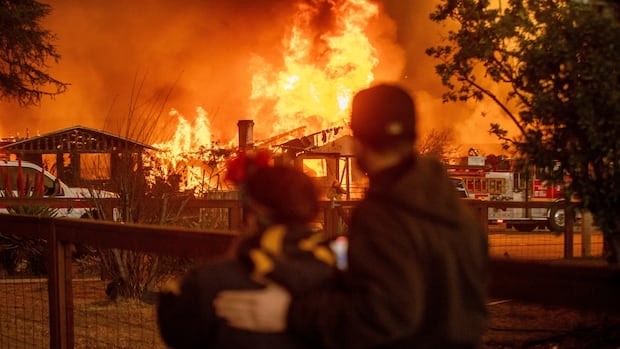Climate Misinformation Spreads During Disasters: Understanding the Phenomenon and Finding Solutions
The devastating wildfires that ravaged Los Angeles in recent months brought not only destruction but also a surge of misinformation. From unfounded theories about lasers and extraterrestrial involvement to misleading explanations for water shortages hindering firefighting efforts, false narratives proliferated rapidly across social media and online platforms. This phenomenon, sadly, is not unique to the Los Angeles fires; similar misinformation campaigns followed the 2023 Canadian wildfires and the Maui fires, highlighting a concerning trend.
Experts like Chris Russill, an associate professor at Carleton University’s School of Journalism and Communication, point out that catastrophic events like wildfires and hurricanes act as "intense and immediate focusing events," drawing a wider audience into the climate change discourse. This influx of attention unfortunately includes individuals and groups invested in propagating climate conspiracies, who seize these moments to spread their narratives. Conspiracy theories, a specific form of misinformation and disinformation, often attribute events to hidden, coordinated actions by powerful entities, further muddying the waters and distracting from evidence-based explanations.
Erin Blondeau, director of communications for the Climate Emergency Unit at the David Suzuki Institute, emphasizes the susceptibility of individuals, particularly those facing social and economic hardships, to the allure of conspiracy theories. These narratives can provide seemingly simple explanations for complex problems, validating feelings of anger and frustration while misdirecting them towards scapegoats. While Blondeau acknowledges the widespread potential for engagement with conspiracy culture, she underscores the heightened vulnerability of those marginalized by social and economic inequalities.
Combating this spread of misinformation requires a multifaceted approach. Blondeau advocates for shifting focus away from online platforms and emphasizes the importance of real-life communication. She suggests fostering accessible forums, such as climate town halls, where individuals can voice their concerns and engage directly with experts and elected officials. Creating spaces for open dialogue between climate skeptics and activists, where shared concerns and aspirations for a sustainable future can be discussed, is crucial for bridging divides.
Russill recommends enhanced information literacy among the public, coupled with stricter regulation of digital platforms where misinformation thrives. He also highlights the vital role of local journalism in countering false narratives. Local news outlets, especially during crises, provide timely and accurate community-specific information—a powerful antidote to misinformation, as evidenced by a 2024 report analyzing the effectiveness of various interventions.
2024: A Record-Breaking Year for Insurance Payouts in Canada
The Insurance Bureau of Canada (IBC) recently announced that 2024 marked the highest insurance payout in Canadian history, reaching $8.55 billion. This surpasses the previous record set in 2016, the year of the devastating Fort McMurray wildfires. Natural disasters, including the Jasper wildfire and widespread flooding in eastern Canada, contributed significantly to this record-breaking figure. Craig Stewart, IBC’s vice-president of climate change and federal issues, highlighted that while flooding typically accounts for the largest portion of insurance claims, unpredictable climate change-driven events are increasingly causing substantial financial damage. A prime example is the 20-minute hailstorm near Calgary that resulted in 70,000 claims and a staggering $2.8 billion in damages, demonstrating the financial vulnerability to extreme weather amplified by climate change.
Innovative Totem Pole Carving Technique Preserves Old Growth Trees
Artist Hayalthkin’geme Carey Newman, along with partner Tejas Collison, is pioneering a revolutionary totem pole carving method that addresses the urgent need to conserve old growth forests. Witnessing the dwindling supply of old growth logs and the ecological impact of felling these ancient giants, Newman felt compelled to find a more sustainable approach to his art. The Totem 2.0 project, born from this responsibility to future generations, utilizes a unique contraption designed by Camosun Innovates, enabling the carving of totems from multiple smaller pieces of second growth wood, thus sparing ancient trees. This innovative technique, developed in collaboration with a technology access centre at Camosun College in Victoria, represents a significant step towards incorporating sustainability into traditional art practices.
Food Waste Apps and Food Banks: A Complex Relationship
The emergence of food waste apps, designed to connect consumers with surplus food at discounted prices, has raised questions about their impact on traditional food bank operations. Food Banks Canada, a national organization supporting thousands of food banks across the country, has strong existing partnerships with major grocery chains, receiving substantial food donations and benefiting from fundraising initiatives. While some argue that food waste apps could divert food away from food banks, others see them as a valuable resource for individuals struggling with food insecurity.
Food Banks Canada emphasizes that corporate donations of surplus food remain consistent, and tax receipts are provided for these contributions. However, the Canada Revenue Agency doesn’t assign a monetary value to donated food commodities, limiting the incentive effect of these tax receipts. Toronto’s Daily Bread Food Bank acknowledges a slight decrease in certain food donations due to food waste apps but recognizes their role in providing affordable food access for individuals experiencing food insecurity. The complex relationship between food waste apps and food banks calls for a balanced approach that acknowledges their respective roles in addressing both food waste and food insecurity.
The Spread of Misinformation and the Power of Local Journalism
[This paragraph expands on the earlier discussion regarding misinformation and the importance of local journalism, referencing specific incidents and expert opinions to emphasize their crucial role in disseminating accurate information, particularly during times of crisis. Further elaboration on information literacy initiatives and the need for better regulation of online platforms could also be included.]
Provocative Ideas from Around the Web: Environmental News and Perspectives
[This section summarizes and expands on the curated list of articles and ideas, providing more context and analysis for each item. For instance, the discussion about US President Trump’s orders regarding climate change information on government websites could be analyzed in greater depth, considering the broader implications for public access to scientific data and the suppression of climate science information. Similarly, the other listed items could be expanded upon to provide a more comprehensive overview of the various environmental topics addressed.]


